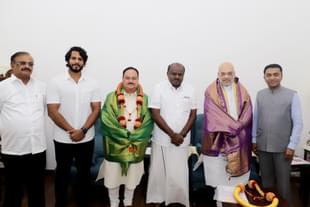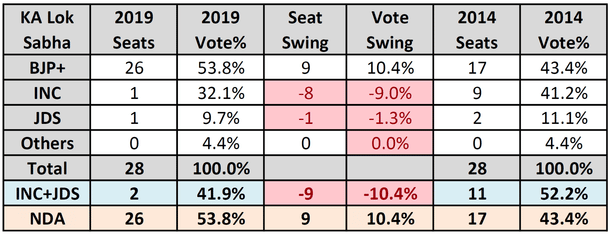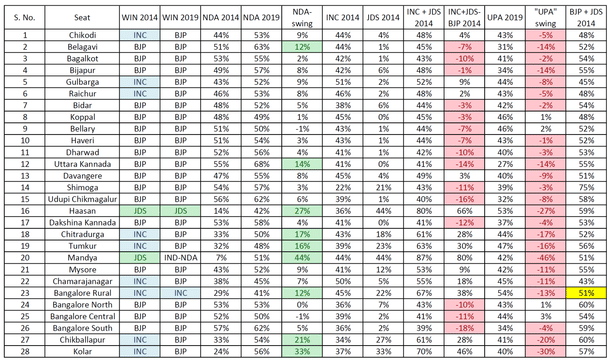Karnataka
Why The BJP-JD(S) Alliance Matters Beyond Karnataka
Venu Gopal Narayanan
Sep 24, 2023, 02:09 PM | Updated 02:09 PM IST
Save & read from anywhere!
Bookmark stories for easy access on any device or the Swarajya app.


The Janata Dal (Secular), the JD(S), formally joined the National Democratic Alliance (NDA) led by the Bharatiya Janata Party (BJP) this week. Electorally, its impact will be limited to Karnataka, but politically, the ramifications of this tie-up are pan-national.
A little background first: In the 2014 general elections, the JD(S), BJP, and the Congress all contested independently. In 2019, the JD(S) joined the Congress. But, instead of sweeping the state, this alliance triggered a massive counter-consolidation of the civilizational vote in favour of the BJP. There was a straight 10 per cent vote swing to the BJP which left the rest reeling.

The bulk of this swing was from the Congress, especially in southern Karnataka, where the BJP had traditionally fared poorly. However, the assembly elections of 2022 were an eye-opener, because the BJP lost badly in a triangular contest, and because a firm trend was established – that Karnataka votes very differently in state and general polls.
The easiest way to understand this is by looking at the combined Congress and JDS vote share in 2014 and 2019 (they contested independently in 2014, and were allied in 2019). We see that if the two parties had been allied in 2014, the BJP would have lost 15 of the 17 seats it won, thereby bringing its total tally under the halfway mark (the BJP won 282; less 15, they would have been at 267).
Conversely, if the Congress had won ten more seats in 2014, they would not have had to suffer the ignominy, of having insufficient numbers to claim the prestigious post of ‘Leader of the opposition’ (they needed 55, but won only 44 seats).

That is how crucial Karnataka is to the political fortunes of national parties. Thus, it is important to ask why the JD(S) and BJP have come together, and what it means?
For the BJP, this alliance with the JD(S) is useful insurance against internal dissent. At the same time, it further increases the BJP’s acceptability among Vokkaliga voters, who constitute the principal vote base of the JD(S). It is also a pragmatic compromise which accepts that banking on a repeat of 2019 might be fatal hubris. Besides, every seat to this alliance means one less to the Congress.
For the JD(S), this alliance is an extension of both life and relevance; the party is clearly withering, and would not survive the passing of its ageing founder, HD Deve Gowda, by too long. By allying with the BJP, it also gets a leg back up to the centre of national politics – a space it had been shut out of for some decades now.
Of course, this alliance with the BJP means that the JD(S) could lose a sizeable portion of its minority vote to the Congress (as it did in the 2022 assembly elections). But is now clear that a party like the JD(S), which hitherto survived solely by identity politics, has finally realized that alienating the Hindu electors through appeasement only leads to political oblivion. In other words, the Muslim vote in Karnataka has been rendered further irrelevant to electoral outcomes there.
This alliance is also the foundation stone for a larger challenge which lies ahead: taking on the Congress in the legislature. A BJP-JD(S) combine is unbeatable, and if they had been allies in 2022, it is the Congress which would have struggled to win a quarter of the seats. In addition, a consolidation of more Vokkaliga votes in NDA ranks means that they are now in a position to not just sweep Karnataka next year, but substantially increase pressure on an already-fractious Congress government, torn between the ambitions of Chief Minister Siddaramaiah and the Congress’ tallest Vokkaliga leader, DK Shivkumar.
Pound to a penny, then, we may well expect acrimonious rifts within the Karnataka Congress unit to widen once the 2024 general elections are over.
This is not good news for the Congress. Apart from the depressing prospects of being wiped out in one of the last states where they still retain a decent hold, it is actually quite possible that they may lose DK Shivkumar’s bastion of Bangalore Rural – a seat where the BJP polled its lowest in 2019, and where the JD(S) still commands a fifth of the vote.
As a result of this alliance, the Congress will now be even more hard-pressed to win 50 seats in the Lok Sabha. Worse, and sensing this, other regional parties in other states would negotiate that much harder with the Congress for seat sharing. Take Bihar, for example: why would Nitish Kumar or the Yadav family give more seats to the Congress if the latter is not in a position to deliver a good number of Lok Sabha seats from a state like Karnataka where it is in government? So too, in Maharashtra.
A smart Congress operator would have invited the JD(S) into the Karnataka cabinet, given the JD(S) a senior ministership or two, and exerted tremendous pressure on the BJP. Alas, they think too much for themselves to think two or three steps ahead.
Consequently, this BJP-JD(S) alliance reduces the index of opposition unity quite significantly, and leaves a ‘dotted coalition’ in tatters even before it has been sewn.
It is simple math: if the opposition can’t get its act together effectively in large states like Karnataka, Maharashtra, or Bihar, then what hope do they have of stopping the BJP-NDA’s juggernaut nationally? As it is, hopes of opposition unity are already lost in states like the Punjab and Kerala (and West Bengal, where Mamata Banerjee, who is cannily playing along for now, knows that an alliance with the Communists and the Congress would only resurrect those very political forces she has striven so hard, and so successfully, to quelch).
As a result, in conclusion, we can expect that this BJP-JD(S) alliance in Karnataka will make the Congress more desperate, and their campaign shriller, more vicious, and more intent on triggering caste divides to try and rake in the OBC vote. Unfortunately, in this day and age, that would only further hand the advantage to the BJP.
Venu Gopal Narayanan is an independent upstream petroleum consultant who focuses on energy, geopolitics, current affairs and electoral arithmetic. He tweets at @ideorogue.





